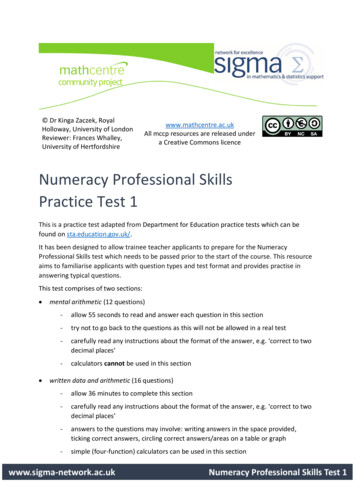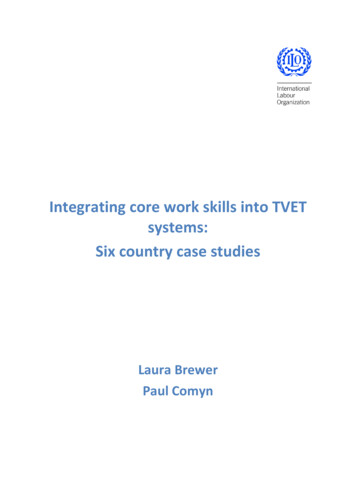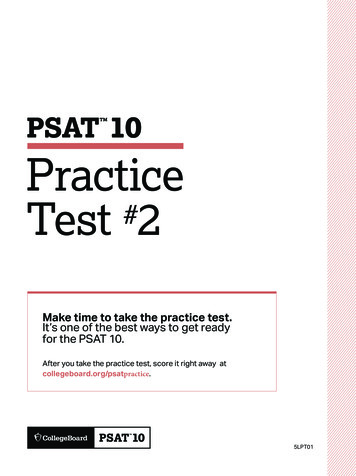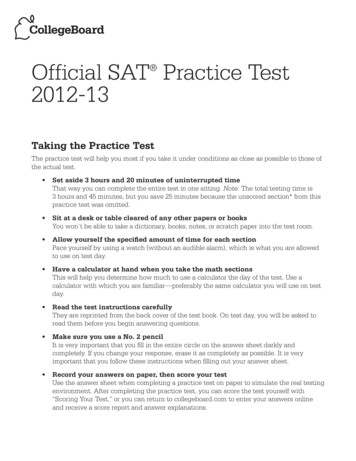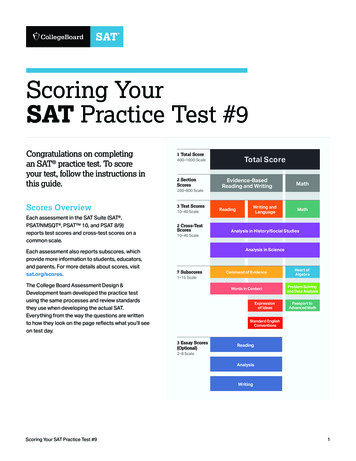
Transcription
Dr Kinga Zaczek, Royal Holloway,University of LondonReviewer: name, institutionwww.mathcentre.ac.ukAll mccp resources are released under aCreative Commons licenceNumeracy Professional SkillsPractice Test 2 - Answerswww.sigma-network.ac.ukNumeracy Professional Skills Test 2 – Answers
Mark SchemeMental Arithmetic SectionQuestionNumber123456789101112Correct Answer(1 mark)𝟐𝟓𝟏𝟓: 𝟑𝟓𝟓. 𝟐𝟔𝟒𝟎. 𝟓𝟎𝟒𝟓𝟎𝟔𝟎 or 𝟔𝟎. 𝟎𝟎𝟓𝟓. 𝟐𝟓𝟔𝟔𝟎. 𝟔𝟏𝟗𝟓𝟕𝟎𝟑0Also Accept(1 mark)0205Do Not Accept(0 marks)40.5450.060.040.5003: 3560.00066.00.60195.070.030.0Written Data and Arithmetic ect Answer(1 mark)Options A and B𝟗𝟔𝟏𝟏 hours and 𝟒𝟓 minutesAlso Accept(1 mark)𝟗. 𝟔𝟎𝟐𝟎𝟏𝟏: 𝟔𝟐𝟐𝟎𝟏𝟐: 𝟔𝟕Pupil BOptions A and C𝟐𝟐𝟎Classes 𝟒𝒄 and 𝟔𝒂𝟎. 𝟑9.69.06.011 hours and75 minutes9.600220.00.300.3330. 3̇𝟏𝟗𝟐𝟓 plain flour,𝟑𝟎. 𝟐𝟓 teaspoons ground ginger,𝟖. 𝟐𝟓 teaspoons ground cinnamonOptions B and C𝟗: 𝟓𝟎𝟓𝟖𝟖𝟔𝟎. 𝟎𝟐Pupil A: 𝟓𝟏Pupil B: 𝟓𝟑www.sigma-network.ac.ukDo Not Accept(0 marks)9: 309: 558860.020Numeracy Professional Skills Test 2 - Answers1
Guidance for Answering the QuestionsMental Arithmetic QuestionsQuestion 1The number of pupils in a class is 20.The number of pupils who got grade A is 8.2The fraction of pupils who got grade A is 5.Further help28 out of 20 is equivalent to: 2 out of 5, which as a fraction is 5.Question 2Pupils left school at 9: 15.The journey one way to Bath takes 1 hour and 40 minutes.The journey from Bath to school also takes 1 hour and 40 minutes, so the total journey time is2 hours and 80 minutes, which is the same as 3 hours and 20 minutes.Pupils spent 3 hours in Bath.Pupils were out of school for 6 hours and 20 minutes.Pupils returned to school at 15: 35.Question 3Zero point zero one is 0.01 written as a decimal.Multiplying by 0.01 is the same as dividing by 100.526 0.01 526 100 5.26Question 4The number of slices of cake sold is 15.The price of one slice of cake is 1.50.The amount of money collected from the sale of cake is 15 1.50 22.50.The number of biscuits sold is 18.The price of one biscuit is 1.00.The amount of money collected from the sale of cake is 18 1.00 18.00.The total amount of money collected for the charity is 22.50 18.00 40.50.www.sigma-network.ac.ukNumeracy Professional Skills Test 2 - Answers2
Question 5The number of classes in a primary school is 18.The average number of pupils in each class is 25.The number of pupils in the school is: 18 25 450.Further helpTo multiply 18 by 25 first think of 18 as 10 8 and multiply both by 25:10 25 2508 25 200.Then add these two results to get the final answer: 250 200 450.Question 6The amount of pocket money John got is 50.00. 1.00 1.20 euros 50.00 is worth 50.00 1.20 60.00 euros.Further helpFirst note that 50.00 is equivalent to 50 and that 1.20 is equivalent to 1.2. To multiply 50 by1.2 rewrite 50 as 10 5 and multiply that by 1.2. When multiplying the order of numbers doesnot matter, therefore, 10 5 1.2 1.2 10 5 12 5 60.Question 7The length and width of a classroom are 8.5𝑚 and 6.5𝑚.The area of a rectangle is calculated by multiplying length by width: 8.5𝑚 6.5𝑚 55.25𝑚2.Further helpOne method to solve the multiplication is by breaking down the second number into easiernumbers: (8.5 6) (8.5 0.5) 51 4.25 55.25.Question 8The number of points pupil scored in the mock GCSE exam is 55.Pupil’s score increased by 20% at the actual GCSE exam.1 120% is equivalent to 5.5of 55 is 11.Pupil got 55 11 66 points in the actual GCSE exam.www.sigma-network.ac.ukNumeracy Professional Skills Test 2 - Answers3
Question 9The number of pupils in a year group is 120.The number of pupils who do not like maths is 48.The number of pupils who like maths is 120 48 72.The proportion of the year group that likes maths: 72 out of 120 is equivalent to 3 out of 5,whis as a decimal is 0.6.Further helpTo simplify a fraction/proportion, look for a number that divides both numbers (the numeratorand the denominator).In the example, both 72 and 120 can be divided by 24 (or in stages by for example 2, 2, 2, 3 orby 4, 6) giving 3 and 5 respectively (i.e. the proportion 3 out of 5).Question 10The distance cycled is 312 kilometres.8 kilometres is approximately 5 miles.8 40 320 kilometres is approximately 5 40 200 miles.312 is: 320 8.So, 312 kilometres is approximately 200 5 195 miles.Alternative method:312 divided by 8 equals 39.39 multiplied by 5 equals 195.Question 11The number of pupils in a year group is 150.The number of pupils achieving grade A or B is 70% of 150 105.The number of pupils achieving grade A is 35.The number of pupils achieving grade B is 105 35 70.Further help770% is equivalent to 10.710of 150 7 15 105www.sigma-network.ac.ukNumeracy Professional Skills Test 2 - Answers4
The number achieving grade A is stated in the question.The number achieving grade B is calculated by subtracting the number achieving grade A fromthe number achieving grade A or B.Question 12The number of classes in a school is 18.The number of pupils in a school is 540.The average number of pupils in each class is 540 18 30.Written QuestionsQuestion 13Statement 1: The range of marks was wider for the Maths test than for the English test.Maximum Maths test mark is 40.Minimum Maths test mark is 3.The range of marks for the Maths test is 40 3 37.Maximum English test mark is 38.Minimum English test mark is 5.The range of marks for the English test is 38 5 33.The range of marks was wider for the Maths test than for the English test.Statement 1 is True.Statement 2: Exactly 50% of pupils did better in English than they did in Maths.The number of pupils who did better in English than they did in Maths is 13.The number of pupils who took both tests is 26.13 out of 26 is a half, i.e. 50%.Statement 2 is True.Statement 3: 13 pupils scored less than 25 marks on the Maths test.The number of pupils scoring less than 25 marks on the Maths test is 12.Statement 3 is False.www.sigma-network.ac.ukNumeracy Professional Skills Test 2 - Answers5
Further helpStatement 1: Range is the difference between maximum and minimum value in the data set.Marks for the Maths test are on the horizontal axis while for English on the vertical axis. To findthe maximum and minimum marks for Maths test, find the most right and most left points(respectively) and read their coordinates on the horizontal axis. To find the maximum andminimum marks for English test, find the highest and lowest points (respectively) on the graphand read their coordinates on the vertical axis.Statement 2: First you need to identify the area on the graph where marks for Maths andEnglish tests are the same. This is the diagonal line passing through points (0, 0) and (40, 40).The points above the line represent pupils who scored more marks in English test than they didin Maths.Statement 3: First imagine a vertical line going up from the mark of 25 on the horizontal axis.All the points to the left from that line represent pupils who scored less than 25 marks on theMaths test.Question 14SubjectPercentage point differenceMaths5English7Humanities2Foreign Language9Physics1Chemistry1Biology3PE4IT2The highest percentage point difference is 9% (Foreign Language).Question 15The number of pupils in School A is 116.The percentage of pupils in School A who like Maths best is 9%.The number of pupils in School A who like Maths best is 9% of 116 10.44 10 (rounded tothe nearest whole number).The number of pupils in School B is 114.The percentage of pupils in School B who like Maths best is 14%.www.sigma-network.ac.ukNumeracy Professional Skills Test 2 - Answers6
The number of pupils in School B who like Maths best is 14% of 114 15.96 16 (roundedto the nearest whole number).The number of pupils who like Maths best in School B is greater by 6 in comparison to School A.Further helpTo calculate a percentage of an amount on a calculator:Method 1: multiply the two numbers together and then divide by 100. e.g. 9% of 116 9 116 100 10.44.Method 2: convert percentage to decimal and multiply it by the number of pupils in the school:e.g. 9% of 116 0.09 116 10.44.Question 16The total time spent on reading is3.5 2.2 0.65 1.3 4.1 11.75 hours 11 hours and 45 minutes.Further help311.75 hours is equivalent to 11 and 4 (three quarters) of an hour.34of an hour is 45 minutes.Question 17The amount of money allowed per pupil is 80.00.The exchange rate at the airport in the UK is 1 4.80𝑃𝐿𝑁.Exchanging 80.00 in the UK each pupil would get 80.00 4.80 384.00𝑃𝐿𝑁.The exchange rate in Poland is higher by 2.5% compared to the rate in the UK, which in Polishmoney is 0.12𝑃𝐿𝑁.The exchange rate in Poland is 4.92𝑃𝐿𝑁.Exchanging 80.00 in Poland, each pupil would get 80.00 4.92 393.60𝑃𝐿𝑁.Exchanging money in Poland, each pupil gets 393.60 384.00 9.60𝑃𝐿𝑁 more than theywould get in the UK.Further helpTo calculate 2.5% of 4.80𝑃𝐿𝑁 you can use one of two methods:Method 1: multiply the two numbers together and then divide by 100. e.g. 2.5% of 4.80 2.5 4.80 100 0.12.www.sigma-network.ac.ukNumeracy Professional Skills Test 2 - Answers7
Method 2: convert percentage to decimal and multiply it by the exchange rate in the UK: 2.5%of 4.80 0.025 4.80 0.12.The question could also be solved using a single calculation 0.025 4.80 80.00 9.60.Question 18The number of pupils achieving A* - C in 2010 was 66.The number of pupils achieving A* - C in 2011 decreased by 6% when compared with theprevious year.Therefore, the number of pupils in 2011 was equal to 94% 0.94 of the number of pupils in2010: 94% of 66 66 0.94 62 (rounded to the nearest whole number).The number of pupils achieving A* - C in 2013 was 69.The number of pupils achieving A* - C in 2013 increased by 3% when compared with theprevious year.Therefore, the number of pupils in 2013 was equal to 103% 1.03 of the number of pupils in2012. Since the number of pupils in the past needs to be found, division has to be used insteadof multiplication (as in the calculation above): 69 1.03 67 (rounded to the nearest wholenumber).Question 19Pupil A:23Final percentage mark 5 (46 60 100%) 5 (70 80 100%) 83.17% 83%rounded to the nearest whole number.Pupil B:23Final percentage mark 5 (43 60 100%) 5 (67 80 100%) 78.92% 79%rounded to the nearest whole number.Pupil C:23Final percentage mark 5 (40 60 100%) 5 (72 80 100%) 80.67% 81%rounded to the nearest whole number.Pupil B got grade B as it is between 70% and 79% inclusive.Question 20Statement 1: In May all three museums had the lowest number of visitors across five months.The lowest number of visitors in the British Museum was in May and it was 603.The lowest number of visitors in the Science Museum was in May and it was 443.The lowest number of visitors in the Natural History Museum was in May and it was 408.www.sigma-network.ac.ukNumeracy Professional Skills Test 2 - Answers8
Statement 1 is True.Statement 2: The smallest difference in the number of visitors between the Science Museum and theNatural History Museum was in September.MonthDifference in the number of visitors between theScience Museum and Natural History Museum35781192541MayJuneJulyAugustSeptemberThe smallest difference in the number of visitors between the Science Museum and NaturalHistory Museum was in August.Statement 2 is False.Statement 3: The Natural History Museum has the widest range in the number of visitors.The range in the number of visitors in the British Museum was 750 603 147.The range in the number of visitors in the Science Museum was 607 443 164.The range in the number of visitors in the Natural History Museum was 670 408 262.The Natural History Museum has the widest range in the number of visitors.Statement 3 is True.Further helpStatement 3: Range is the difference between the biggest and smallest value.Question 21It took 20 pupils to feed 176 cows.One pupil feeds on average 176 20 8.8 cows.25 pupils would feed 8.8 25 220 cows.Question 22The table describes the trend for each class.Consistent trend of improvement is when values improve by the same amount each month.Class4aIs trend of improvement consistent?Nowww.sigma-network.ac.ukNumeracy Professional Skills Test 2 - Answers9
4b4c5a5b5c6a6b6cNoYes, 0.3 each monthNoNoNoYes, 0.4 each monthNoNoThe classes showing consistent trend of improvement are 4c and 6a.Question 23The table describes the percentage point change for each class.Class4a4b4c5a5b5c6a6b6cPercentagepoint change1.51.11.51.300.7252The number of classes is 9.The number of classes achieving at least two percentage points increase in attendance over thesix-month period is 3.The proportion of classes achieving at least two percentage points increase in attendance overthe six-month period is 3 out of 9 1/3 0.3 rounded to one decimal place.Question 24The amount of butter pupils have is 550𝑔. This is 550 100 5.5 times as much as in therecipe.To follow the recipe, pupils need 5.5 times as much of other ingredients as in the recipe.The amount of plain flour pupils need is 350𝑔 5.5 1925𝑔.The amount of ground ginger pupils need is 5.5 5.5 30.25 teaspoons.The amount of ground cinnamon pupils need is 1.5 5.5 8.25 teaspoons.www.sigma-network.ac.ukNumeracy Professional Skills Test 2 - Answers10
Question 25Statement 1: Some pupils achieved less than 20% in Mathematics.The value for the mode indicates that at least one pupil achieved a percentage mark of 52%.The range of marks is 30%.So the lowest mark in Mathematics cannot be lower than: 52 30 22%.Statement 1 is False.Statement 2: At least one pupil achieved more than 60% in English.The lowest mark possible is 0%.The range of marks is 67%.If someone obtained 0% then the highest mark in the class would be 67%.So, whatever the lowest score for the class, the highest mark will be at least 67%.Statement 2 is True.Statement 3: All pupils achieved at least 20% in Science.The value for the mode indicates that at least one pupil achieved a percentage mark of 70%.The range of marks is 50%.So the lowest mark in Science cannot be lower than: 70 50 20%.Statement 3 is True.Question 26The race distance is 10 kilometres.The time race started is 9: 00.The average speed of the winner is 7.5 miles per hour.8 kilometres is approximately 5 miles.Time is calculated by dividing distance over speed. However, both, speed and distance have tobe in terms of the same unit for distance.10 kilometres equals 10 5/8 6.25 miles.The amount of time it took to complete the race is 6.25 7.5 0.83̇ hour 50 minutes.The winner completed the race at 9: 50.www.sigma-network.ac.ukNumeracy Professional Skills Test 2 - Answers11
Question 27The amount of money collected in the UK: 116.50 132.22 15403.63 Kenyan Shillings.The amount of money collected in France: 148 116.05 17175.40 Kenyan Shillings.The amount of money collected in the U.S.A.: 253.80 103.55 26280.99 Kenyan Shillings.In total 15403.63 17175.40 26280.99 58860.02 Kenyan Shillings was sent to supportthe mission.Question 28Pupil A achieved 40% in test 1.The mark of pupil A increased by 27% in test 2, i.e. pupil A achieved 127% of mark in test 1.Pupil A achieved 127% of 40% 1.27 40% 50.8% 51% rounded to the nearestwhole number.Pupil B achieved 62% in test 1.The mark of pupil B decreased by 15% in test 2, i.e. pupil A achieved 85% of mark in test 1.Pupil B achieved 85% of 62% 0.85 62% 52.7% 53% rounded to the nearest wholenumber.www.sigma-network.ac.ukNumeracy Professional Skills Test 2 - Answers12
This resource was produced by the sigma Network Employability Special Interest Group whosemembers are: Dr Kinga Zaczek, Royal Holloway, University of LondonFrances Whalley, University of HertfordshireDavid Faulkner, University of HertfordshireLaura Hooke, Loughborough University Londonwww.sigma-network.ac.ukNumeracy Professional Skills Test 2 - Answers13
The range of marks for the Maths test is 40 3 37. Maximum English test mark is 38. Minimum English test mark is 5. The range of marks for the English test is 38 5 33. The range of marks was wider for the Maths test than for the English test. Statement 1 is True. Statement 2: Exactly . 50%

